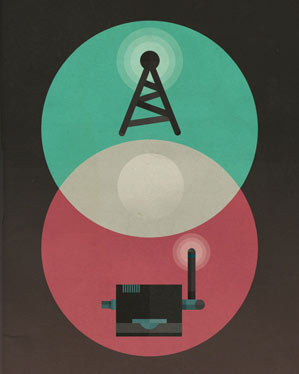A Banner Year for Mobile Devices
In the last quarter of 2012, people around the world were projected to buy 225 million smartphones—a 40 percent jump from the last quarter of 2011—adding up to around 700 million sold this year. This epic uptake of powerful mobile devices, plus tablets, marked the defining trend of the year and spurred the creation of new communications technologies, business models, and wireless policy changes.

This period of extraordinary growth didn’t feature any major new product breakthroughs and included an uncharacteristic stumble by Apple over the terribly flawed mapping app the company introduced in September. The competition between major handset makers spawned continuing court battles that may inhibit technology development. Still, consumers are using more data than ever as they buy new devices and switch to 4G LTE networks, which can have 10 times the capacity of the older 3G networks. And the major carriers are nurturing new data-hungry wireless business models in everything from cars to health care.
Faced with all of this surging data demand, concerns peaked in the United States and elsewhere that spectrum might soon run out, though from a technology perspective, many experts found this fear overblown. In July, the White House released a landmark report from the President’s Committee of Advisors on Science and Technology that encouraged a new policy of sharing, rather than auctioning, spectrum. In December, the U.S. Federal Communications Commission voted to share a slice of newly released spectrum previously used by military radar systems. So-called small cells, which can be easily installed in buildings and neighborhoods and flexibly handle different frequencies, are being used to meet demand and make use of this new sharing scheme. And new research is leading to devices that are faster and more versatile at spectrum sharing. In the meantime, some startups came up with novel ways to deliver service on unlicensed bands, such as the ones used for garage doors and baby monitors.
New efforts emerged this year to speed data delivery on both fixed and mobile networks. Google’s “Google Fiber” division opened up a one-gigabit-per-second service in Kansas City, in part as a means to facilitate the company’s ever-improving TV service. Officials in Chattanooga, Tennessee, tried to figure out how to interest consumers and businesses in using the city’s own one-gigabit service, installed by the city utility as part of a smart-grid effort. And the Web-optimization company Akamai said it was working on ways to speed up delivery of data to mobile phones, too.
Meanwhile, the trend toward real-time communications helped create new classes of products and services. And police departments have started to harness the power of data analytics and communications to get a better handle on crime hot spots and, in some cases, stop illegal activity before it happens. And President Obama’s successful reëlection campaign exploited sophisticated communications, data analytics, and nimble use of online social networks.
The year also saw fundamental communications technology breakthroughs. An MIT spinout company called Eta Devices has come up with a far more efficient power amplifier that, in theory, could slash base station energy use by half and greatly extend smartphone battery life. Similarly, research advances in the field of network coding—algorithms that convey wireless data more efficiently with less back-and-forth traffic—showed the potential to deliver 10 times as much data in many situations, using no more spectrum.
Innovation also continued in the developing world, where mobile communications technologies and business models showed promise for helping deliver basic health information and services to some of the world’s poorest people, and provide new insights into epidemics. New African social networks arose and spawned new mobile business models. And new apps for banking and commerce even arose for simple feature phones.
Meanwhile, parts of the United States remain stuck with antiquated infrastructure. Ten years after 3G’s introduction in the United States, many sparsely populated and poor regions, and many Indian reservations, cannot yet participate in the smartphone and wireless applications boom because they get no signal. The FCC expects to subsidize broadband expansion through $50 million in one-time aid to tribal areas and $500 million a year to build out infrastructure to serve dead spots in rural areas. And amid all of the great advances, there still might be a few Achilles’ heels—new questions arose over whether 4G LTE networks might be so complex that very simple jamming attacks could shut down much of a city’s network. But, as with the Mayan doomsday, no such calamity has yet come to pass. And 2013 looks to be shaping up as another banner year for mobile communications business and technology advances.
Keep Reading
Most Popular
Large language models can do jaw-dropping things. But nobody knows exactly why.
And that's a problem. Figuring it out is one of the biggest scientific puzzles of our time and a crucial step towards controlling more powerful future models.
The problem with plug-in hybrids? Their drivers.
Plug-in hybrids are often sold as a transition to EVs, but new data from Europe shows we’re still underestimating the emissions they produce.
Google DeepMind’s new generative model makes Super Mario–like games from scratch
Genie learns how to control games by watching hours and hours of video. It could help train next-gen robots too.
How scientists traced a mysterious covid case back to six toilets
When wastewater surveillance turns into a hunt for a single infected individual, the ethics get tricky.
Stay connected
Get the latest updates from
MIT Technology Review
Discover special offers, top stories, upcoming events, and more.